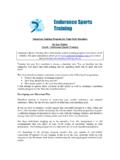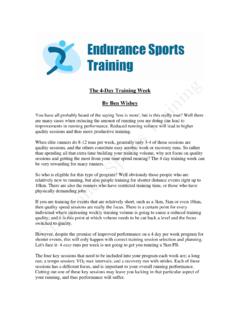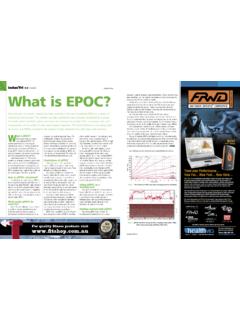Transcription of Training for a 10k Event1 - Endurance Sports Training
1 Training for a 10k Event By Ben Wisbey Introduction Many runners set their sights on running the marathon as they feel they have no speed, and are therefore not suited to shorter races, such as 5 and 10km s. This is generally because recreational runners devote minimal time to speed development. Instead they develop Endurance , and feel that because they can finish a marathon, they are better suited to longer events. However, those runners who have the patience to develop speed for shorter distances will realise even greater benefits when they decide to take the step up the marathon. Building speed before Endurance is always the best method of enhancing long-term performance.
2 This article will give you a taste of speed Training as it includes an eight-week Training program designed to develop your running so you can complete a 10k race in your desired time. The program assumes a basic level of fitness, allowing you to complete the first week relatively comfortably. If you feel as though you might struggle with the beginning weeks of the program, then a period of bridging may be required. To do this build your aerobic fitness by completing predominantly aerobic runs over a 3-6 week period. How do you assess your goal time for the 10km? If you have not done a 10km event before it is important to work out a realistic goal time.
3 This is important not only in terms of your racing plan but also for correct Training speeds. The best way to establish 10km goal time would be to use previous race times as a goal, for example, using 5km race time, you should prepare for a 10km time of about times your 5km time. For example, if you have recently completed a 5km in 22:00, then you should aim for a 10km time of about 46:12 ( 22:00 x = 46:12). Obviously this is a generalised rule. It should only be used as a guide when you don't have previous 10km experience to go on. Once you have decided on your goal race time, then choose the Training program that is closest to that goal.
4 For example if you believe that you goal time is 45 minutes for the 10k, then simply choose the 40 minute program and adjust some of the Training speeds to meet your goal time. The Physiology of the 10km For optimal results in a 10km you will need to run at an intensity slightly above your anaerobic threshold. This is quite intense in terms of physiological demand, particularly for those wishing to achieve the distance in between 40 and 60 minute. The primary difference between the 5km and 10km in terms of demand is that the 10km uses a greater amount of aerobic energy, and therefore strength and Endurance are also very important.
5 For these reasons, the primary focus of any 10km program should be boosting anaerobic threshold, improving aerobic Endurance , and developing strength to minimise fatigue during the event. Although these characteristics are the primary focus, approximately 15-20% of energy for the 10km is produced anaerobically. Therefore the anaerobic system also needs to be trained- through the use of VO2 max intervals. Training for the 10km Without writing an individualised Training program it is difficult to establish a weekly Training program. This program provides key sessions and lets you structure the weekly key sessions into your working week.
6 It is important that you have at least one easy day or day off between all hard days. Hard days are those days in which you complete the key sessions that are listed below. Essential Sessions for the 10km The three key sessions that we will use to prepare you for the 10km are a longer aerobic run, a speed/VO2 session, and a session we will term cruise intervals. The 8-week Training program is detailed below, however a summary of each session type is first required. Long Aerobic Run This session should be completed once weekly, and is aimed at improving aerobic Endurance , strength and fatigue resistance. This run should ideally be completed over natural undulating terrain and at a moderate/comfortable intensity for the duration of the run.
7 Speed / VO2 Session This weekly intensity session has two components to it. Each of these components will be emphasised at different times of the Training program. The speed portion of the session is conducted as a series of high-speed efforts ranging from 200-300m in length. These efforts are aimed at improving your maximal speed and running economy. This improved running economy will filter down to slower speeds as well, such as your 10km race speed. Each speed repetition is conducted in a fresh state, to allow to you hold good posture, and achieve high speeds. While these efforts are done at a high speed, they should not be a maximal sprint; focus on being fast, tall and in control of your technique.
8 The second part of the session is conducted after 4-5 minutes of easy running to allow recovery from the speed repetitions. These VO2 intervals are slightly longer, ranging in distance from 600-1000m in length. The aim is to boost your VO2 Max., sustainable running speed and increase your understanding of pacing. Between each effort a short recovery of between 90 seconds and 2 minutes is had, thus only partial recovery is allowed. These sessions should be completed on a track. Cruise Intervals Cruise intervals are slightly longer intervals done at a speed a little slower than 10km race pace. The aim of cruise intervals is to improve anaerobic threshold, strength and running economy.
9 These intervals should not be done too hard, as this negates the purpose of the session. However, by doing 4-7 minute intervals the session becomes quite stressful. Ideally, this session should be conducted on natural terrain that is predominantly flat, with a few small rises, such as ovals or golf course. All sessions should have a warm up and cool down. All sessions should begin with a 10-12 minute warm-up. This should be made up of 6-8 minutes of easy jogging and then some drills to take your limbs through a wide range of motion, such as high knees and butt kicks. It is also a good option to complete some short stride outs, especially prior to speed sessions.
10 It is also essential to complete an 8-10 minute cool down at the end of each session. This will enhance recovery will allow you to back up for your next session feeling fresher and ready to go. In the program details below, the duration of the weekly long run includes 10 minutes of warm-up and 10 minutes of cool down. So, when a 60 minute run is scheduled, this includes 10 minutes warm-up as above, 40 minutes at the desired pace/intensity, and then 10 minutes cool down. All extra runs should be recovery The key weekly sessions are outlined in the program below. There is only 3 sessions that need to be completed as part of the structured program each week.



